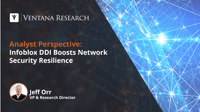I am happy to share insights gleaned from our latest Buyers Guide, an assessment of how well software providers’ offerings meet buyers’ requirements. The Cloud Computing Platforms Ventana Research Buyers Guide is the distillation of a year of market and product research by ISG and Ventana Research.
Read More
Topics:
Cloud Computing,
Digital Technology
Embracing artificial intelligence technologies opens doors for innovation and efficiency. Alongside these opportunities, however, come risks. Threat actors are keenly aware of the potential impact of AI systems and are actively exploring ways to manipulate them. In this Analyst Perspective, I explore the world of adversarial machine-learning threats and provide practical guidance for securing AI systems.
Read More
Topics:
Digital Technology,
AI & Machine Learning,
Digital Security,
Generative AI,
DevOps and Platforms,
Model Building and Large Language Models,
Machine Learning Operations,
NIST,
Model Training
ServiceNow is a global software provider that has developed a cloud computing platform that helps organizations manage digital workflows for enterprise operations. The provider uses its annual Knowledge user conference to educate customers and showcase product announcements. Ventana Research had the opportunity to attend the Knowledge 2024 event and provides this analyst perspective to summarize what transpired.
Read More
Topics:
IT Service Management,
Digital Technology,
natural language processing,
Field Service,
AI & Machine Learning,
Digital Security,
Observability,
Generative AI,
ITOps,
Intelligent Automation
The technology landscape for enterprise IT faces a daunting challenge: complexity. As systems grow more intricate, organizations must actively seek ways to simplify the technology stack. This process, known as decomplexification, is crucial for enhancing efficiency, security and collaboration within an enterprise.
Read More
Topics:
Cloud Computing,
IT Service Management,
Digital Technology,
Digital Security,
IoT and Edge Computing,
ITOps,
DevOps and Platforms,
Intelligent Automation,
IaC,
CI/CD,
SASE
Enterprises are increasingly recognizing the need to streamline operations for efficiency, agility and innovation. This has led to various “operations” or “Ops” initiatives, each focusing on a specific aspect of enterprise IT. From software development and data analytics to IT and cloud management, these Ops groups are transforming the way enterprises operate and compete.
Read More
Topics:
Analytics,
Cloud Computing,
Digital Technology,
data operations,
digital finance,
Digital Security,
Observability,
Analytic Operations,
ITOps,
DevOps and Platforms,
CloudOps,
Machine Learning Operations,
MLOps,
AIOps,
NetOps,
SecOps,
DevSecOps,
SecFinOps,
ProjectOps
Is your organization prepared for the increasingly sophisticated and pervasive cyber threats that are challenging enterprise CIOs and IT leaders? Our previous analyst perspective underscored the importance of protecting digital assets and driving business growth with Continuous Threat Exposure Management (CTEM) — a proactive approach to identifying and managing cyber threats. In this perspective, we delve into the crucial business and technology considerations that enterprises must weigh when...
Read More
Topics:
Digital Technology,
Digital Security,
Security Posture,
CTEM,
Continuous Threat Exposure Management,
Threat Management,
Threat Landscape,
SOC
Cyber threats are becoming more sophisticated and pervasive, posing a major challenge for CIOs and IT leaders. To protect their digital assets and drive business growth, they need a new approach to security: Continuous Threat Exposure Management (CTEM). CTEM software continuously monitors and manages the enterprise’s exposure to cyber risks, enabling a swift and effective response to any security incident. In this analyst perspective, we will explore how CTEM software works, why it is essential...
Read More
Topics:
Digital Technology,
Digital Security,
Security Posture,
CTEM,
Continuous Threat Exposure Management,
Threat Management,
Threat Landscape,
SOC
The migration of on-premises applications to the cloud has become more than just a technological shift; it’s a strategic imperative for enterprises. This transition, driven by the need for competitiveness, agility and responsiveness in a rapidly evolving business environment that operates at the speed of digital, is not a simple task. It requires a careful balance between the technology roadmap and the strategic business objectives of the organization.
Read More
Topics:
Cloud Computing,
Digital Technology,
Migration,
CloudOps
Ventana Research recently announced its 2024 Market Agenda for Digital Technology. This agenda is designed to provide expertise to enterprises across various industries, helping them prioritize technology investments that enhance workforce effectiveness, customer engagement and enterprise agility. Digital Technology is especially important for CIO and Chief Digital Officers looking to rationalize and modernize their IT portfolio. Our expertise will see a significant expansion on this topic in...
Read More
Topics:
Business Continuity,
Cloud Computing,
IT Service Management,
Digital Technology,
Digital Security,
Observability,
IoT and Edge Computing,
ITOps,
DevOps and Platforms,
Intelligent Automation
Imagine a world where artificial intelligence (AI) seamlessly integrates into every facet of your business, only to subtly distort your data and skew your insights. This is the emerging challenge of AI hallucinations, a phenomenon where AI models perceive patterns or objects that do not exist or are beyond human detection.
Read More
Topics:
Digital Technology,
AI & Machine Learning
In the evolving landscape of business operations, intelligent automation has emerged as a key driver of productivity, operational efficiency and workforce satisfaction. Each facet of an organization perceives the value of automation through the lens of its unique objectives and goals. In a previous perspective, I shared the reasons why enterprise organizations are leaning towards automating business and technology workflows, highlighting three pivotal business and technology trends that are...
Read More
Topics:
Digital Technology,
robotic automation
Ensuring digital effectiveness requires insights into how enterprises can provide the best outcomes through people, processes and technologies. Armed with those insights, business and technology investments can effectively innovate and streamline organizational processes.
Read More
Topics:
Digital Technology,
AI & Machine Learning,
robotic automation
In today’s rapidly evolving digital security landscape, organizations face the challenge of maintaining robust network security resilience. Chief information officers battling increasingly sophisticated cyber threats and the growing complexity of enterprise networks must enhance network security posture with advanced technologies to stay ahead of potential threats. One such technology is DDI – the integration of DNS, DHCP and IPAM.
Read More
Topics:
digital business,
Digital Security,
Resilience,
DNS,
IPAM,
DDI,
DHCP,
Security Posture
Network security resilience is the ability to withstand and recover from cyber-attacks. To achieve this, organizations need to use DDI technology. DDI stands for DNS, DHCP and IPAM. These are three services that help devices connect and communicate on a network.
Read More
Topics:
digital business,
Digital Security,
DNS,
IPAM,
DDI,
DHCP
The acquisition of Splunk by Cisco marks a significant milestone in the digital security industry. This strategic move combines the strengths of two industry leaders, offering a suite of products and services underpinned by artificial intelligence technologies. However, like any major business decision, it comes with challenges and potential risks. Ventana Research presents an analysis of the strengths, weaknesses, opportunities and threats associated with this acquisition, offering valuable...
Read More
Topics:
digital business,
Digital Security,
Observability
Software supply chain digital security is a hot topic, especially after cyberattacks on SolarWinds, Colonial Pipeline and Kaseya. These attacks have exposed the vulnerabilities and risks that exist in the software products and services that organizations rely on for their daily operations. How can organizations protect themselves from these threats and ensure the quality and integrity of software products? One possible approach is to adopt a software bill of materials (SBOM).
Read More
Topics:
digital business,
Digital Security
Data is one of the most valuable assets an organization owns, and a robust data backup and recovery system is foundational to protecting it. Weak data protection efforts jeopardize resilience and business continuity. With data residing in multiple places – including on-premises servers and public and private cloud environments – it is difficult to ensure that all data is backed up and recoverable in the event of a disaster.
Read More
Topics:
Business Continuity,
Cloud Computing,
digital business,
Digital Security,
Backup,
Recovery,
Resilience,
Multi-Cloud
Governance, risk management and compliance are essential tactics for a successful organization. Effective GRC practices help organizations achieve business objectives, mitigate risks and ensure compliance with laws and regulations. As a chief information officer or IT leader, it is important to evaluate new technologies and determine their impact on the business, including whether they fit within the scope of current GRC programs and processes.
Read More
Topics:
Data Governance,
AI & Machine Learning,
digital business,
Digital Security,
Governance & Risk
Given the ever-expanding digital footprint of most businesses today, visibility into the performance of distributed systems has become a necessity. There are more data sources and data storage locations than ever before. As organizations continue to expand their data presence and scale their systems and tools, digital security is of greater importance in the architecture and operations. Monitoring is a fundamental enabler of digital security that provides real-time detection of cyber threats...
Read More
Topics:
digital business,
Digital Security
Enterprise organizations remain vulnerable to a host of security attacks. Cyberattacks are often associated with techniques that have never been seen before, which lead to data breaches if not quickly detected and remediated. However, one of the most common vulnerabilities for an organization is phishing. Phishing lures people to give up confidential information by clicking on a link or opening a file in an email from what appears to be a trusted source but is actually a bad actor....
Read More
Topics:
digital business,
Digital Security
The role of the chief information officer has evolved from managing IT to maximizing technology for business value. Many organizations launch digital transformation programs to identify and deliver the desired value but discover that digital transformation is a complex, lengthy process. Budgets and resources can be quickly exhausted with little to show for the investment. Yet business objectives remain.
Read More
Topics:
Digital Technology,
Customer Experience Management,
robotic automation,
Work Management
Intelligent automation is a powerful tool that can help the CIO and IT leaders optimize business processes and outcomes while reducing costs, risks and errors. Automation takes many forms, each with its own applications, benefits and limitations. In a previous perspective, I shared how technology helps organizations automate processes and enhance workflow efficiency. This perspective explains the various types of automation enabled by artificial intelligence technologies and their applications...
Read More
Topics:
Digital Technology,
AI & Machine Learning,
robotic automation
Automation uses technology to perform tasks or functions that would otherwise require human intervention or effort. Automation has existed for decades, and it takes many forms. It handles routine tasks, freeing time for knowledge workers to perform other activities that require creativity, subjectivity or empathy. Automation can also improve the quality, efficiency and consistency of business processes as well as enhance customer satisfaction and brand loyalty.
Read More
Topics:
Digital Technology,
AI & Machine Learning,
robotic automation
Increasing threats and challenges from cyberattacks, data breaches and other incidents have made digital security a critical concern for organizations. These dangers have devastating consequences, including financial loss, reputational damage, legal liabilities and operational disruption. Adopting effective and efficient digital security strategies is key to protecting data, assets and customers from risk.
Read More
Topics:
digital business,
Digital Security
Cloud computing has emerged as the catalyst for a shift from digital transformation to digital modernization. This technology offers many advantages, including heightened agility, cost reduction, improved collaboration, enhanced security and accelerated innovation. Hybrid and multi-cloud strategies offer distinctive strengths that enable organizations to optimize the IT infrastructure necessary for digital transformation and modernization efforts.
Read More
Topics:
Cloud Computing,
Digital Technology
With the growing threat landscape and increasing reliance on technology, digital security has become a critical concern. What constitutes digital security, and how is it different from cybersecurity? How are the roles of the chief information officer and chief information security officer evolving to meet digital security needs? To explore these questions, we must understand the impact of digital transformation and modernization and identify strategies for success. I’ll also set the stage for...
Read More
Topics:
digital business,
Digital Security
A lot has been written about the definition of generative artificial intelligence (AI) and large language models (LLMs), though less has been written about the business considerations for an organization to evaluate adopting and implementing these technologies. And more importantly, does the technology align with the Office of the CIO objectives and the goals of the business? The value of generative AI software must be put into terms that all stakeholders can relate to. And organizations cannot...
Read More
Topics:
Digital Technology,
natural language processing,
AI & Machine Learning,
Collaborative & Conversational Computing
The digital transformation movement was about making wholesale changes in the use of technology across all lines of business and functions. It required organizational change on a large scale, including adapting the organization’s culture, retraining or rehiring the workforce and process realignment. Change management and a significant time commitment to implement change were necessary while maintaining existing operations.
Read More
Topics:
Cloud Computing,
Digital Technology,
digital business,
Governance & Risk
I am happy to announce that I have taken on a new role at Ventana Research to lead the firm’s overall research and advisory for the CIO and technology leader practice. The area focuses on digital modernization and the transformation necessary for IT teams to be successful across an organization. The market coverage spans Cloud Computing, Digital Security, Generative AI and the technologies driving Intelligent Automation.
Read More
Topics:
Digital Technology







































